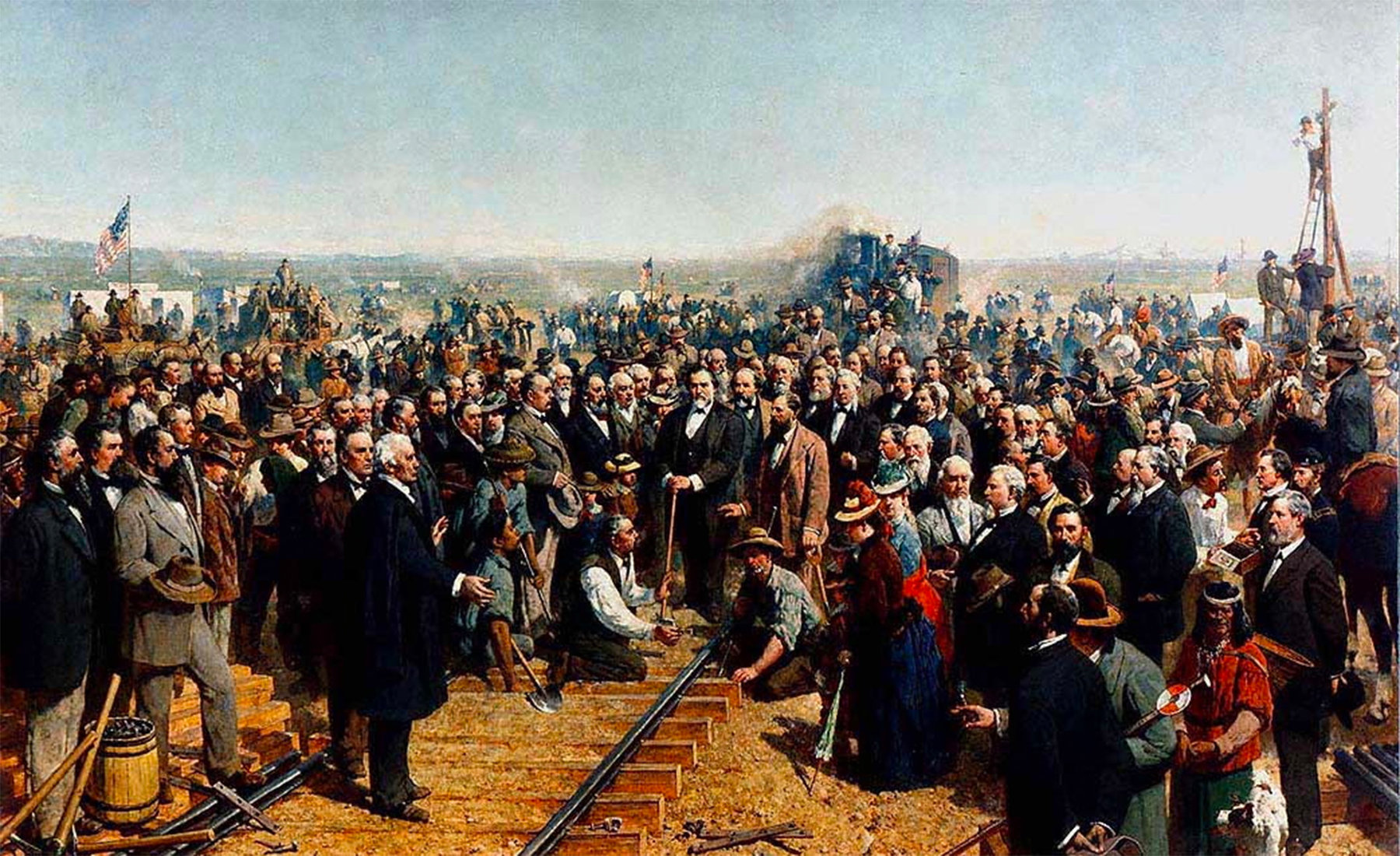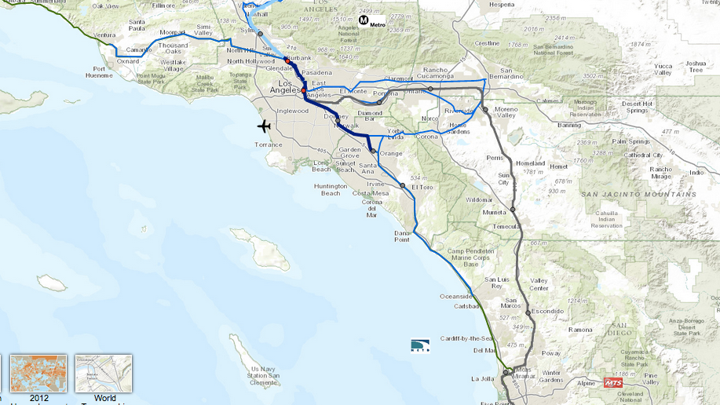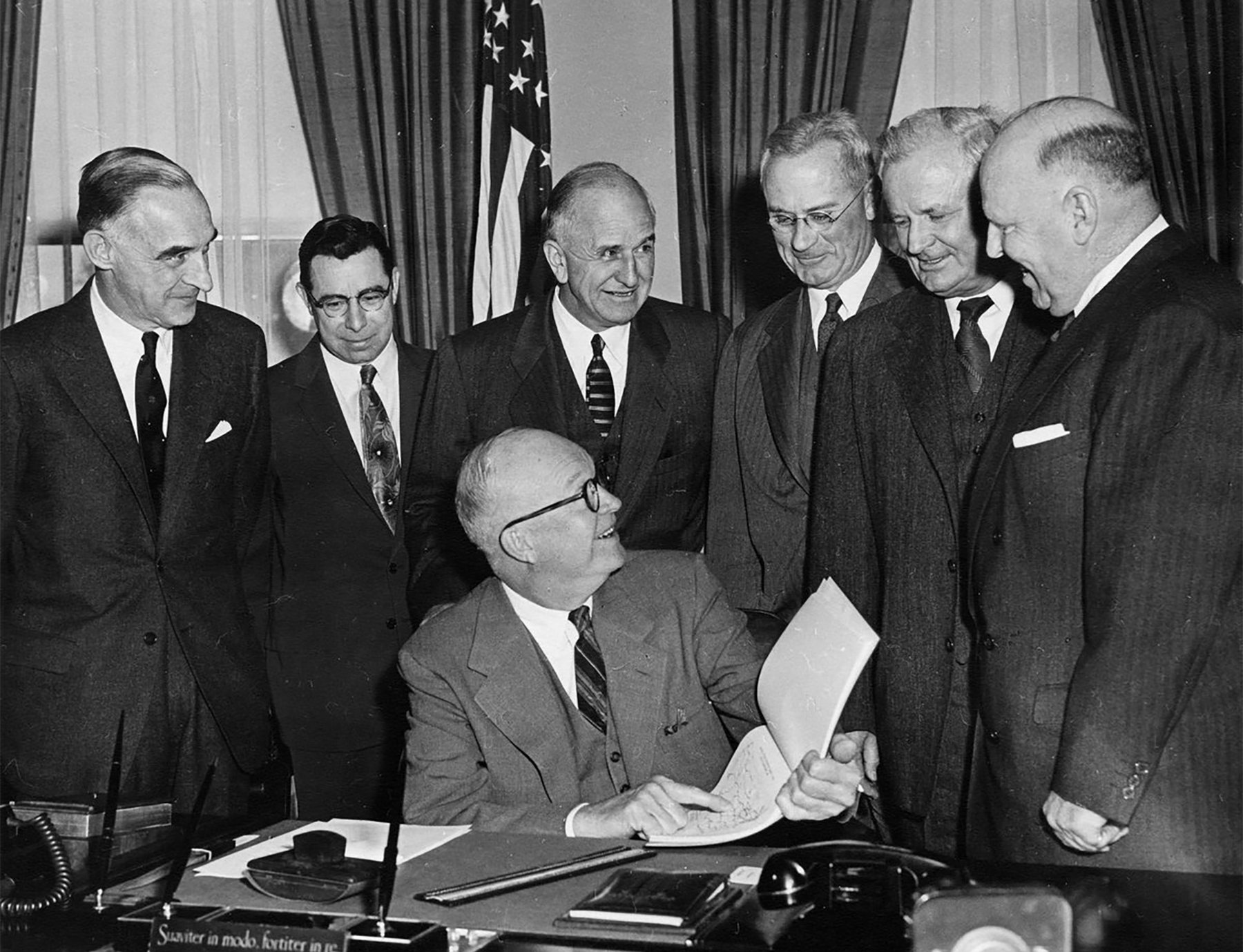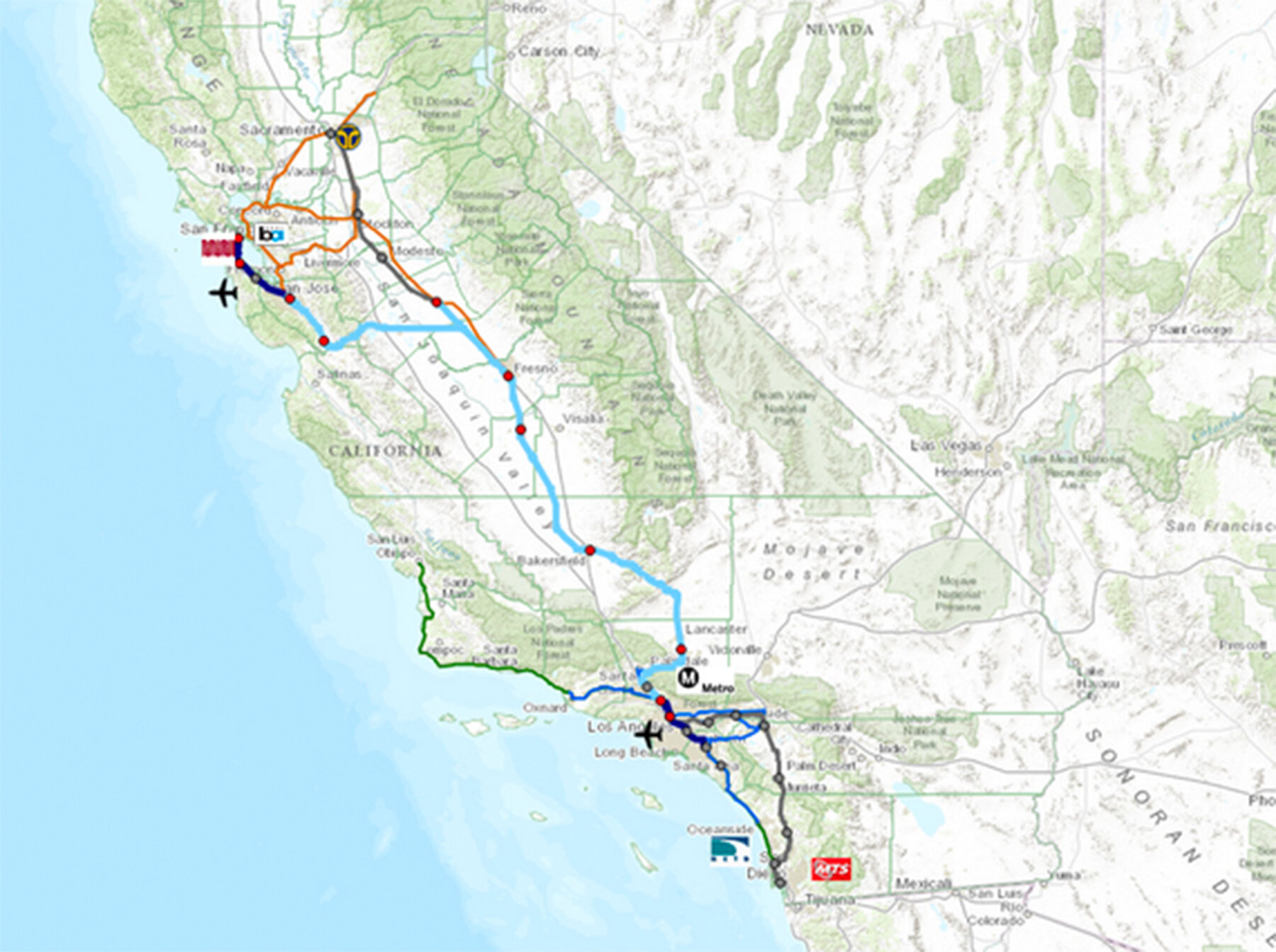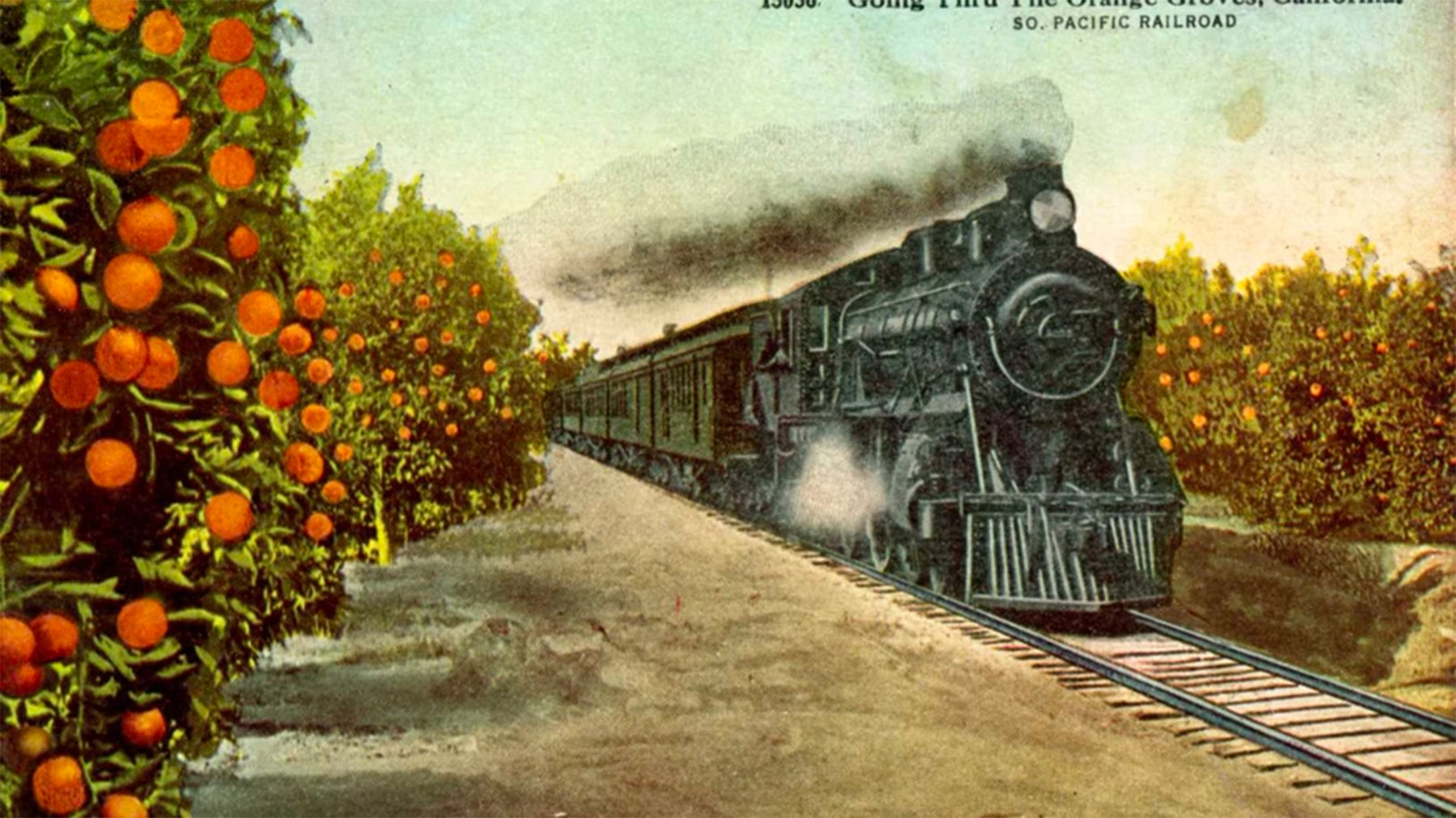As a reminder: California’s plan to build a north-south High-Speed Rail (HSR) system is the most ambitious and important infrastructure project now being contemplated anywhere in the United States. It has also become one of the most controversial. Jerry Brown, now running for an unprecedented fourth term as governor, has stuck with HSR as his signature/legacy project.
Projected Southern California reach of HIgh-Speed Rail Project (UC DAVIS AND ESRI)
He is opposed by Republicans, probably most significantly in the form of Representative Kevin McCarthy, Eric Cantor’s successor as House Majority Leader, who is trying to deploy federal leverage against the plan, as described in this NYT piece. He has also run into resistance from his own lieutenant governor, the former mayor of San Francisco Gavin Newsom. (Both are Democrats, but this is very much a Jerry Brown rather than a Brown-Newsom administration. Newsom, in his mid-40s, is part of the generation of politicians waiting for the current Brown/Feinstein/Boxer cohort of statewide officials, now ages 73 through 81, to move on.) And there is resistance on a variety of other fronts.
Today, 10 views from 10 readers. Actually, there are a lot more than 10 views in what you’ll see below! This is a small sampling of the mail that has come in, which I’ve chosen to reflect main or recurrent themes. Here we go:
Earlier this year I took EuroStar from London to Paris—my first time doing so since I moved to the US seven years ago. Two moments I remember vividly:
1) I checked the times and prices on their website, internalized them, opened a new tab in Chrome, and then realized that there was nothing to type. I’m so accustomed to having a myriad of choices when flying within the US that my brain instinctively says “OK, option 1 understood, now let’s look at option 2”. But there is no alternative to eurostar when traveling from central London to central Paris, unless you have lots of time to spare. So I booked the eurostar—the price was reasonable, and the schedule had hourly trains.
2) Seeing the English countryside woosh by, being in the tunnel only twenty minutes, and then being delivered to the heart of Paris. I was in awe of how pleasant an experience travelling between two cities can be.
Putting these together: I see that I, as a consumer, value choice and competition, but when lack of choice/competition is the necessary cost of undertaking very ambitious projects then I’ll happily accept that compromise. Highly ambitious projects leap civilization forward, whereas choice and competition let me save a few percent at checkout.
2) Let’s leap forward, but to self-driving cars.
I’m a fan of Brown’s high-speed train system, but the thing that will make the most difference in CA (I’m living in San Jose now) will be self-driving cars—not purchased by individuals, but rented by individuals for the time necessary to get them where they want to go.
I’ve been pushing the notion of an 2024 Olympics bid for the Bay area that would replace light rail expansion with thousands of self-driving cars. We’ve got Google; we’ve got Tesla. It’s about time to get amateur drivers off the streets (i.e., all of us).
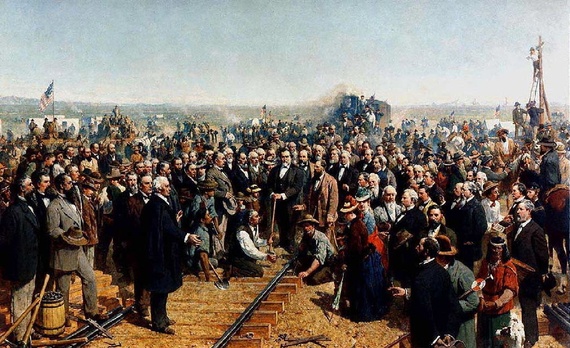
3) In theory, yes. In practice, no.
Just my two cents on your discussion about California HSR. I agree with your correspondent who said they support it in theory. I love the idea of high speed rail. I just have strong doubts given the cost and implementation strategy for exactly the reasons that person stated.
In addition, I just think if the goal is to reduce traffic congestion, the State could get a much better return for less money by investing in expansion and improvement of the existing rail services across the state. For example, the Metrolink commuter rail service in the LA region is very popular, but due to limited funds can only expand very slowly even though there is proven demand. Same with the LA metro-rail program, the Amtrak California service etc. etc.
4) Will it pay off in door-to-door travel? From a reader now on the East Coast:
Lived in both SF and LA for a total of 8 years combined and have taken the flight between them more times that I can remember.
Just looked on Kayak—$134 R/T from Oakland to Burbank, 4 weeks out. Both easy airports to use, arrive at the airport 1 1/2 hours ahead of your flight and the total travel time is 2 hours 45 minutes.
$81 billion to provide a service that will be much slower and more expensive than flying.
This particular HSR proposal is not only a solution looking for a problem that doesn’t exist, it is the mother of all pork barrel projects – lots of high paying jobs for something that no one needs, wants or will use.
I’m not going to comment on most of these, but here I’ll add: this doesn’t seem to be the right cost-and-time comparison. Air fares obviously rise when you change plans at short notice, and rail fares generally don’t. Thus for a lot of business trips the air cost would be higher. And the “total” travel time leaves out the overhead of getting to and from the airports.

As a frequent commuter to LA from Sacramento, I’ve had deep questions about the financial viability of the HSR. People choose their travel mode to LA from the Bay Area and Sacramento … for different reasons:
Airplane: speed and convenience, with some pricing advantages in some cases. This is the true place for market share competition with HSR. These travelers are without a car when they arrive as they would be in the HSR. However LA is so decentralized and the mass transit system too complicated for a periodic visitor/tourist to use, so a downtown HSR doesn’t confer a real advantage over arriving at Burbank (the experienced travelers’ preference) or LAX. (Note also that the vaunted Bay Area transit system is only robust in the northern half—it’s as difficult as LA’s in San Jose environs.) Southwest Air seems able to meet any price challenge, and can be less costly than driving alone. Boeing’s recent foray into bio jet fuel indicates that airplanes may be able to reduce their GHG emissions even more significantly…
Auto: cost, spontaneity and convenience on arrival. Avoiding rental car costs of nearly $50/day is an important consideration, and traveling in a group is always less expensive than an airline ticket. The HSR will have almost NO penetration into this market—I have not seen an financial projections that show ticket prices competing with driving instead of airplanes. And if EVs are as successful as the ARB AB 32 Scoping Plan envisions, driving costs will drop precipitously, so the HSR is even less likely to There is currently little congestion outside of the Bay Area and the LA Basin (and that HSR riders will be driving around means there will be no relief there) and if congestion arise in the Central Valley, expanding I-5 and Hwy 99 from 4 to 6 lanes (or creating a separate truck-only road along I-5) will quickly address that problem.
Which brings me to two key issues I have not yet seen discussed:
1) The real pollution problem in the Central Valley is not auto travel between the Bay Area and LA. Trucks making the I-5 trek are a much bigger source, and agriculture, oil production and local traffic probably overwhelm the Bay Area/LA traffic stream, particularly since autos emit less criteria pollutants per mile at freeway speeds. I don’t see the HSR will make a real dent in the overall emission levels.
2) Viewing the HSR in isolation from EV penetration and airline bio jet fuel use illustrates a much larger problem in California: The failure to analyze the interplay among different emission reduction strategies. The Scoping Plan was a mess this way—it was clear that reductions in one sector would reduce the potential emissions in another, but the Plan failed to account for this effect. The HSR probably is not cost effective when compared to other measures in this manner, and the GHG allowances probably could be used much more effectively in other ways (e.g., mitigating AB 32 price increases on low income consumers). A comprehensive, holistic analysis is completely missing.
It’s also naïve to think that there will be any train ridership between Fresno and Bakersfield for the first leg just at one reader noted. There’s no advantage for train travel because there is parking shortage in either place and no real traffic congestion except briefly at rush hour ….
I’m afraid that California is going to kill HSR just as it did electricity restructuring and GHG cap and trade programs. I generally supported both of those, but the state’s execution reflects the growing political ossification that prevents real vision.
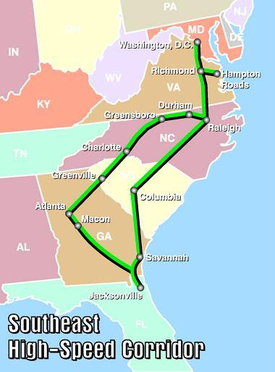
6) “Infrastructure is the real thing. Yet we are behind … even the French!”
I’m so glad you’ve taken up this issue. I do hope that it broadens into a deeper discussion of the need for infrastructure investment throughout the country…
The word “infrastructure” gets thrown around like so many metaphors which become mindlessly absorbed into a kind of bureaucrat-ese; they make the speaker sound knowledgeable and on the inside. (Like referring to hotels and movies as “properties” as if speaking clinically about such things elevates the speaker to the dispassionate management elite.)
But “infrastructure” is as close to a literal metaphor as anything I can think of. If you look at the development of this country, the movement west, the development of commerce throughout the interior of the country; it was all of it hung on the firm grounding of infrastructure. Initially the infrastructure was natural—Pittsburgh arose at the confluence of three great rivers. The Erie Canal brought commerce and development to interior NY state, eastern Ohio and the Great Lakes. See also the St. Lawrence Seaway. Would Duluth, Cleveland, Detroit, etc., have become anything without it?
Railroads made possible all of the great agricultural activities in the country’s interior; so many towns arose simply because of the railroads. So many centers of commerce arose simply because of the interstate highways. (And so many in downtown cores were lost because of those same highways…) Regulated telecommunications made sure that the hard-to-wire regions of the interior nevertheless got reliable telephone service. Consider the questionable viability of all of the small towns in Arkansas, Oklahoma, Nebraska, etc. had telephone service to them not been a regulatory requirement. See also air service in the regulated era. The level of commercial and domestic development on the interior of the country could not have happened had it not had all of that publicly financed or mandated infrastructure upon which to hang. And all of it depended in one form or another on public investment and subsidy. Even the railroads.
By comparison, look at us now. Whatever happened to the vast Greyhound and Continental Trailways bus network? It used to be possible to go most anywhere by passenger rail. The de-regulation of the airlines has caused the cessation of commercial air service to large numbers of smaller, but significant, centers of commerce. Interstate highways still provide access, but it’s necessary to have an inefficient and expensive automobile to use it, absent some commercial service. And high-speed internet still remains elusive to rural areas that are not commercially viable on their own. If this is the result of the “free market,” you can have it. We moved from the Articles of Confederation to the Constitution specifically to have greater support for our national commerce.
Infrastructure is a real thing, and without it, the skin and the muscle and the sinews have nothing to hang onto, no grounding against which to leverage its force. Human activity won’t go anywhere if there’s no way for it to go.
The Reagan and neo-Reagan political era have brought with it a kind of auto-immune (clever pun?) disease in which government investment is reviled, and the country eats away at itself. (Correction. I guess we still find the benefit in public investment in our sports stadiums.) Our attitudes of public and regulated private investment for the benefit of the whole have to change, or we will, as we are, decay to a level from which it may not be possible to recover. Why can’t we chant “USA! USA! USA!” and actually accomplish something other than tearing apart third world countries? Two and a half efficient and convenient hours from SFO to LAX? You betcha. I’ll have more of that thank you!
High-speed rail technology has been available for 50 years. It is an embarrassment that we are so far behind … even the French!!
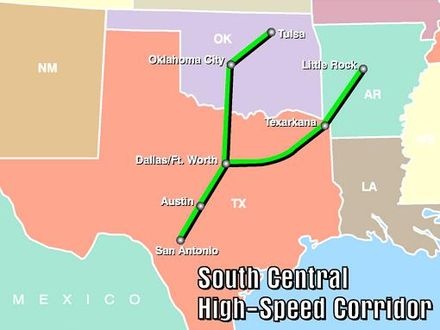
I have lived in Southern California for most of my life except for a few college years in the Bay Area. I have driven and flown between the two metro areas more times than I could count over the past 50 years.
I remember the days when we would park a car at LAX on a Friday after work, walk into the terminal, buy a ticket and walk on the plane, then rent a car at SFO and be in downtown San Francisco in time for dinner.
Today, for a trip to SF you can figure an hour for each of the following:
-get to LAX and park
-allow an extra hour for delays in airport screening
-check in, screening and boarding
-flying time
-rent a car at SFO
-drive to your destination in SF area
Total time: 6 hours
Driving time: door to door if you live north of downtown LA : 7 hours
How is the high speed rail going to make this faster? Eventually high speed rail stations will become giant messes like todays airports.
Door-to-door transit time is what counts. I would never think of flying to Las Vegas even though i live minutes from Orange County airport. And driving, is, of course much cheaper.
Rather than the HSR we should focus on the urban transportation infrastructures of getting people between airports and their homes; and, improving the nightmarish ‘people-processing’ situation at our airports. And, what the heck, go ahead and impose a $50 toll on single occupancy vehicles driving between LA and SF. I would still drive.
And, why not start with something more modest: build decent rail transport between Los Angeles and San Diego. No one flies between those two urban areas. You would displace a lot of auto traffic by building good rail service. It doesn’t even have to be `high speed’. Current Amtrak, Coaster and Metrolink service is pathetic. Double track the entire distance between Orange County and San Diego; separate track usage between passenger and freight trains.
A brief reply here: the chairman of the HSR project, Dan Richard, explained in a previous round why the bond act authorizing the project required the first phase to go northward from Los Angeles toward San Francisco, rather than southward toward San Diego.
8) “The Valley is skewed toward short-term expectations.”
Two thoughts: (A) the expectations from the Bay Area; (B) my concerns about access to stations.
(A) I think the [Silicon] Valley is skewed through short-term expectations from the tech startup world as well as instantaneous payback and financial self-support within 5-7 years. “How will it ever pay for itself” often only looks at the short-term revenue-from-tickets divided by cost-to-build-and-maintain—and not the ratio of industrial-impact divided by cost-to-build-and-maintain.
With Tech IPOs and mergers and acquisitions fueling a large percentage of people who live in the Bay Area, I heard few bankers saying: “I will pay a much higher price for the stocks because in 15-20 years this will create tons of jobs and prevent us from many mistakes.” Furthermore, I’d like to remind people on the recent “star” IPOs and deals in Tech and BioTech:
• EPZM – market cap of 1bn, EV/EBITDA of -395.74
• XON – market cap of 2.3bn, operating margin of -213.13%
• FEYE – market cap of 5.16bn, operating margin of -118.94%, EV/EBITDA of -20.77
• BNFT – market cap of 300m, operating margin of -132.73%
• FUEL – market cap of 800m, EV/EBITDA -47.11, but an ok operating margin of -6.82%
• TWTR – market cap of 22bn, EV/EBITDA -32.67, operating margin of -92.54%
• KIN – market cap of 305m, no revenue.
• XLRN – market cap 836m, operating margin of -18.43%, $20m debt
• VMEM – market cap 356m, operating margin of -139.12%,
• CHGG – market cap 506m, operating margin -20.51%
But generally, look at the debt leverage of these companies as well, and think about what kind of assets are in the company. Sure, some patents, and for some of them actual biotech equipment, but FUEL is leveraged 11.45x, for example; VMEM is 9.34x leveraged at -31.62m levered free cash flow; CHGG has a -60.16m levered free cash flow.
I think by numbers alone the HSR might look better 😉
(B) The difference of HSR in Europe and Asia to the US is the access to the stations: European cities were built around train stations: see Frankfurt, Hannover, London, Amsterdam.
If I have to take a car to the train station somewhere in Oakland/Berkeley and then wait for a train that is coming up from San Diego with 1h delay (remember 500 miles! London-Brussels is only 225 miles with a single stop, etc.), just to end up far outside Sacramento and to take a bus in again, I might as well drive.
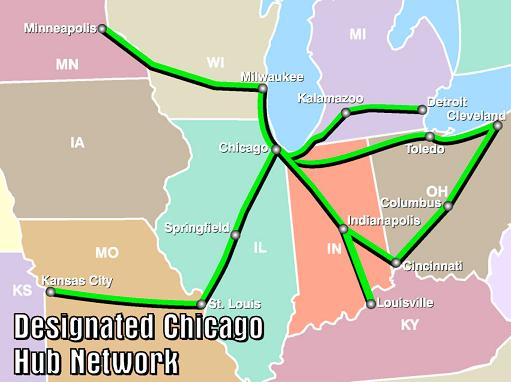
Interesting piece on the high-speed rail. May be worth noting that this ‘build almost to where you want to go’ seems to be a common dodge these days; a way to make it harder for governments not to fund the useful part of a project for Phase II. There are 2 examples of this approach in Seattle.
First, the light rail to the airport was first built, well, not to the airport. It stopped about a mile or two away. Of course, that lead to outcry, and guess what? The ‘useful’ part was ultimately built.
Same thing is happening with the replacement of the 520 floating bridge. [This is the Highway 520 bridge that crosses the northern end of Lake Washington.] A new, 6-lane bridge is being built from the east side. As it approaches Seattle, it will be joining into the existing, decrepit, 4 lane bridge. Anyone think the piece to actually connect this to I-5—the ‘useful’ part—will not be funded?
A cowardly approach to infrastructure work, which ultimately wastes money and results in sub-optimal designs, but I guess that’s all we can hope for these days.
10) A chance for California to lead the way? From a reader in the Pacific NW, where California doings are often regarded with suspicion:
Thank you for your work on the California HSR system. I agree with your assessment that it is critical infrastructure work. I think there is another angle that you should bring up in a later piece: the path lighting that California is doing. If Cali succeeds, it will show that true HSR can be a success in America, unlocking the option for the rest of us. I was disappointed that the Obama administration was forced to take small actions on 110 mph trains in the Midwest instead of doing the bold but correct thing.
Here in the Northwest, we are watching eagerly. Like California, we have state sponsored trains (Amtrak Cascades) that are a very pleasant way to get around. It just happens that they are held up by having to share tracks with freight trains and are not as quick as they could be. There are many incremental improvements to be made, but a great leap forward may only be possible when inspired by success in California.
For the record: This post is No. 5. See also No. 1, No. 2, No. 3, and No. 4. Also see the interactive map showing different planned construction phases of the project, put together by UC Davis, the HSRA, and the mapping team at Esri, here. Also for the record: there are two of these posts that come very close to expressing my own view on the project. More of that, and other pros and cons, to come.

